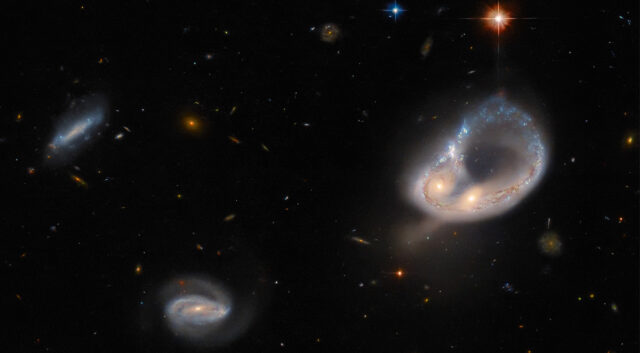The Hubble Space Telescope has survived more than a decade in orbit without a servicing mission, but it still manages to produce some of the most stunning images and detailed astronomical observations. Case in point, a new snapshot of a galaxy merger known as Arp-Madore 417-391. Hubble pointed its mirror toward these distant interacting galaxies to discover an unusual ring-like formation.
Arp-Madore 417-391 sits around 670 million light-years away in the southern constellation Eridanus. The galaxies may eventually settle into a single, large elliptical galaxy, but for the time being, the collision looks quite messy. The two galactic cores are visible on one side of the formation, and a vast ring has bloomed on the other.
This image comes from Hubble’s Advanced Camera for Surveys (ACS), which was added to the telescope in a 2002 servicing mission. In the past 20 years, the ACS has been responsible for some of the most iconic images of the cosmos, including the Hubble Ultra Deep Field and Abell 1689 (with its 2-million-light-year-wide gravitational lens).
Hubble also used the ACS in 2012 to make accurate measurements of how our Milky Way galaxy is moving with respect to the nearby Andromeda galaxy. Astronomers concluded that the galaxies will collide in about 4 billion years (and it might not be our first). When it happens, the results could be similar to what we see happening with Arp-Madore 417-391.
Astronauts James H. Newman (on the remote manipulator system robotic arm) and Michael J. Massimino install ACS during Servicing Mission 3B. Credits: NASA
You may be wondering why we’re seeing Arp-Madore 417-391 via Hubble instead of the newer and more advanced James Webb Space Telescope — that’s actually the eventual goal. Webb, which just came online earlier this year after more than 20 years of planning and construction, is still in high demand among astronomers. It’s necessary to prioritize observations so that Webb can have the biggest possible impact on astronomy during its life. Unlike Hubble, Webb is too far away for servicing missions.
Thus, Hubble is helping out by conducting observations of previously unobserved objects like Arp-Madore 417-391. The team is fitting these observations in whenever they can in between other scheduled campaigns. Eventually, astronomers will build up a list of objects that warrant follow-up with Webb and advanced ground-based telescopes.
Now read:



Source link


